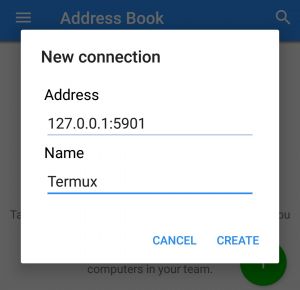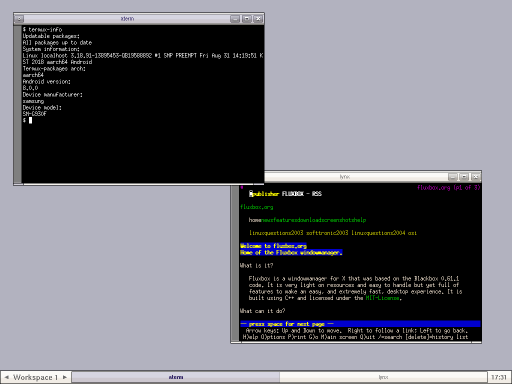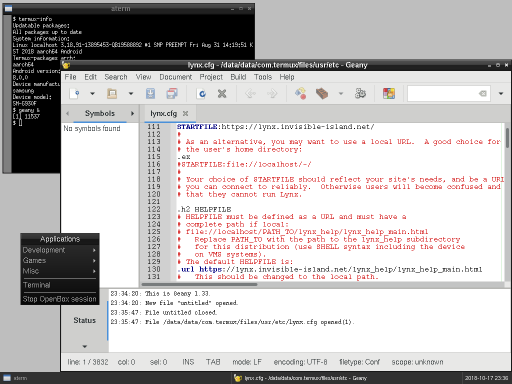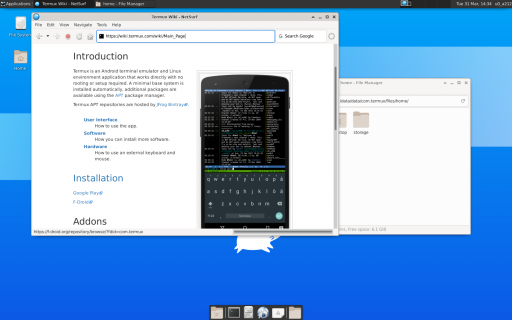Graphical Environment: Difference between revisions
m (→Openbox) |
(lxqt: run start lxqt instead of lxqt-session) |
||
| (30 intermediate revisions by 9 users not shown) | |||
| Line 1: | Line 1: | ||
'''This article is only applicable only to Termux installations running on Android 7.0 or higher.''' | |||
Termux provides support for programs that use X Window System. However, there no hardware acceleration for rendering and user will have to install a third party application to view graphical output. | Termux provides support for programs that use X Window System. However, there no hardware acceleration for rendering and user will have to install a third party application to view graphical output. | ||
| Line 8: | Line 10: | ||
* [https://play.google.com/store/apps/details?id=x.org.server XServer XSDL] - this one may be unstable but it provides a standalone Xorg server so you don't have to setup VNC. | * [https://play.google.com/store/apps/details?id=x.org.server XServer XSDL] - this one may be unstable but it provides a standalone Xorg server so you don't have to setup VNC. | ||
== Enabling X11 | * [https://github.com/nwrkbiz/android-xserver Android XServer] - Only implements the core X11 protocol. Shares clipboard between android / X11 and includes a window manager. | ||
== Enabling the X11 Repository == | |||
X11 packages are available in a '''separate''' APT repository. You can enable it by running the following command: | X11 packages are available in a '''separate''' APT repository. You can enable it by running the following command: | ||
| Line 29: | Line 33: | ||
2. After installation, execute this: | 2. After installation, execute this: | ||
vncserver | vncserver -localhost | ||
At first time, you will be prompted for setting up passwords: | At first time, you will be prompted for setting up passwords: | ||
| Line 79: | Line 83: | ||
Termux | Termux | ||
</pre> | </pre> | ||
*If you are using VNC client on a computer using the same network as the phone does, make sure you correctly start a VNC session and know the IP address of the device. | |||
3. Now launch it. You will be prompted for password that you entered on first launch of 'vncserver'. Depending on packages you installed, you may see either entirely black screen or terminal prompt (only if 'aterm' is installed). | 3. Now launch it. You will be prompted for password that you entered on first launch of 'vncserver'. Depending on packages you installed, you may see either entirely black screen or terminal prompt (only if 'aterm' is installed). | ||
== Setting up XServer== | |||
Xserver setup is nearly same as for VNC. The only differences are that you don't have to configure authentication and variable "DISPLAY" should be set like | |||
export DISPLAY=localhost:0 | |||
Note that you don't need to set variable "PULSE_SERVER" like application suggests because Termux uses its own Pulseaudio package. | |||
== Window Managers == | == Window Managers == | ||
When using Android XServer rather than Android XSDL these are optional. | |||
=== Fluxbox === | === Fluxbox === | ||
| Line 126: | Line 143: | ||
</syntaxhighlight> | </syntaxhighlight> | ||
Don't put anything else to file <code>~/.vnc/xstartup</code> but only lines shown above since Openbox has own autostart script. It is located at <code>${PREFIX}/etc/xdg/openbox/autostart</code>. Edit this file like here: | Don't put anything else to file <code>~/.vnc/xstartup</code> but only lines shown above since Openbox has own autostart script. It is located at <code>${PREFIX}/etc/xdg/openbox/autostart</code> (or alternatively at <code>~/.config/openbox/autostart</code>). Edit this file like here: | ||
<syntaxhighlight lang="bash"> | <syntaxhighlight lang="bash"> | ||
| Line 135: | Line 152: | ||
pypanel & | pypanel & | ||
</syntaxhighlight> | </syntaxhighlight> | ||
== Desktop environment == | |||
It is possible to setup a full blown desktop environment in Termux. Only XFCE, LXQt and MATE is supported. | |||
=== XFCE === | |||
[[File:Termux XFCE.png|border|512px|XFCE + NetSurf + Thunar]] | |||
Recommended way of installation is through metapackage and not the separate components: | |||
pkg install xfce4 | |||
VNC server startup configuration (<code>~/.vnc/xstartup</code>) should contain only | |||
<syntaxhighlight lang="bash"> | |||
#!/data/data/com.termux/files/usr/bin/sh | |||
xfce4-session & | |||
</syntaxhighlight> | |||
Additional recommended packages for installation: | |||
* <code>netsurf</code> - Simple graphical web browser. Javascript is not supported. | |||
* <code>xfce4-terminal</code> - Terminal emulator for XFCE. It is not included as part of XFCE installation to allow use of <code>aterm</code> or <code>st</code>. | |||
=== LXQt === | |||
Recommended way of installation is through metapackage and not the separate components: | |||
pkg install lxqt | |||
VNC server startup configuration (<code>~/.vnc/xstartup</code>) should contain only | |||
<syntaxhighlight lang="bash"> | |||
#!/data/data/com.termux/files/usr/bin/sh | |||
startlxqt & | |||
</syntaxhighlight> | |||
Additional recommended packages for installation: | |||
* <code>otter-browser</code> - Free and open source web browser that aims to recreate aspects of Opera 12.x | |||
* <code>qterminal</code> - Terminal emulator for LXQt. It is not included as part of LXQt installation to allow use of <code>aterm</code> or <code>st</code>. | |||
=== MATE === | |||
As of right now, there is no MATE metapackage. So, you need to install all required MATE components serperately | |||
pkg install mate-* marco | |||
VNC server startup configuration (<code>~/.vnc/xstartup</code>) should contain only | |||
<syntaxhighlight lang="bash"> | |||
#!/data/data/com.termux/files/usr/bin/sh | |||
mate-session & | |||
</syntaxhighlight> | |||
Additional recommended packages for installation: | |||
* <code>netsurf</code> - Simple graphical web browser. Javascript is not supported. | |||
* <code>mate-terminal</code> - Terminal emulator for MATE. It is not included as part of MATE installation to allow use of <code>aterm</code> or <code>st</code>. | |||
== Notes == | |||
- Currently hardware acceleration is not supported by default. | |||
== See also == | == See also == | ||
* [https://github.com/termux/x11-packages Sources for X11 packages] | * [https://github.com/termux/x11-packages Sources for X11 packages] | ||
Latest revision as of 10:59, 31 January 2023
This article is only applicable only to Termux installations running on Android 7.0 or higher.
Termux provides support for programs that use X Window System. However, there no hardware acceleration for rendering and user will have to install a third party application to view graphical output.

To use X11-enabled programs, please, make sure that at least one of the following programs is installed:
- VNC Viewer - the best choice for interacting with graphical environment. Requires a running VNC server.
- XServer XSDL - this one may be unstable but it provides a standalone Xorg server so you don't have to setup VNC.
- Android XServer - Only implements the core X11 protocol. Shares clipboard between android / X11 and includes a window manager.
Enabling the X11 Repository
X11 packages are available in a separate APT repository. You can enable it by running the following command:
pkg install x11-repo
It will automatically add appropriate sources.list file and PGP key.
To disable this repository, you need to uninstall package x11-repo.
Setting up VNC
Server
If you decided to use VNC for graphical output, follow these instructions for properly setting up VNC server.
1. Install package `tigervnc`:
pkg install tigervnc
2. After installation, execute this:
vncserver -localhost
At first time, you will be prompted for setting up passwords:
You will require a password to access your desktops. Password: Verify: Would you like to enter a view-only password (y/n)? n
Note that passwords are not visible when you are typing them and maximal password length is 8 characters.
3. If everything is okay, you will see this message:
New 'localhost:1 ()' desktop is localhost:1 Creating default startup script /data/data/com.termux/files/home/.vnc/xstartup Creating default config /data/data/com.termux/files/home/.vnc/config Starting applications specified in /data/data/com.termux/files/home/.vnc/xstartup Log file is /data/data/com.termux/files/home/.vnc/localhost:1.log
It means that X (vnc) server is available on display 'localhost:1'.
4. Finally, to make programs do graphical output to the display 'localhost:1', set environment variable like shown here (yes, without specifying 'localhost'):
export DISPLAY=":1"
You may even put this variable to your bashrc or profile so you don't have to always set it manually unless display address will be changed.
Client
Here will be assumed that you use this Android VNC client: VNC Viewer (developed by RealVNC Limited).

1. Determine port number on which VNC server listens. It can be calculated like this: 5900 + {display number}. So for display 'localhost:1' the port will be 5901.
2. Now open the VNC Viewer application and create a new connection with the following information (assuming that VNC port is 5901):
Address: 127.0.0.1:5901 Name: Termux
- If you are using VNC client on a computer using the same network as the phone does, make sure you correctly start a VNC session and know the IP address of the device.
3. Now launch it. You will be prompted for password that you entered on first launch of 'vncserver'. Depending on packages you installed, you may see either entirely black screen or terminal prompt (only if 'aterm' is installed).
Setting up XServer
Xserver setup is nearly same as for VNC. The only differences are that you don't have to configure authentication and variable "DISPLAY" should be set like
export DISPLAY=localhost:0
Note that you don't need to set variable "PULSE_SERVER" like application suggests because Termux uses its own Pulseaudio package.
Window Managers
When using Android XServer rather than Android XSDL these are optional.
Fluxbox
Simplest way to get a working graphical environment is to install Fluxbox:
pkg install fluxbox
It can be started automatically on VNC server startup. To do this, edit file ~/.vnc/xstartup as shown here:
#!/data/data/com.termux/files/usr/bin/sh
## Fluxbox desktop.
# Generate menu.
fluxbox-generate_menu
# Start fluxbox.
fluxbox &
Openbox
Openbox requires a more complicated configuration than Fluxbox. Firstly you need to install some packages:
pkg install openbox pypanel xorg-xsetroot
Put the following lines to your ~/.vnc/xstartup:
#!/data/data/com.termux/files/usr/bin/sh
# Start Openbox.
openbox-session &
Don't put anything else to file ~/.vnc/xstartup but only lines shown above since Openbox has own autostart script. It is located at ${PREFIX}/etc/xdg/openbox/autostart (or alternatively at ~/.config/openbox/autostart). Edit this file like here:
# Make background gray.
xsetroot -solid gray
# Launch PyPanel.
pypanel &
Desktop environment
It is possible to setup a full blown desktop environment in Termux. Only XFCE, LXQt and MATE is supported.
XFCE
Recommended way of installation is through metapackage and not the separate components:
pkg install xfce4
VNC server startup configuration (~/.vnc/xstartup) should contain only
#!/data/data/com.termux/files/usr/bin/sh
xfce4-session &
Additional recommended packages for installation:
netsurf- Simple graphical web browser. Javascript is not supported.xfce4-terminal- Terminal emulator for XFCE. It is not included as part of XFCE installation to allow use ofatermorst.
LXQt
Recommended way of installation is through metapackage and not the separate components:
pkg install lxqt
VNC server startup configuration (~/.vnc/xstartup) should contain only
#!/data/data/com.termux/files/usr/bin/sh
startlxqt &
Additional recommended packages for installation:
otter-browser- Free and open source web browser that aims to recreate aspects of Opera 12.xqterminal- Terminal emulator for LXQt. It is not included as part of LXQt installation to allow use ofatermorst.
MATE
As of right now, there is no MATE metapackage. So, you need to install all required MATE components serperately
pkg install mate-* marco
VNC server startup configuration (~/.vnc/xstartup) should contain only
#!/data/data/com.termux/files/usr/bin/sh
mate-session &
Additional recommended packages for installation:
netsurf- Simple graphical web browser. Javascript is not supported.mate-terminal- Terminal emulator for MATE. It is not included as part of MATE installation to allow use ofatermorst.
Notes
- Currently hardware acceleration is not supported by default.


